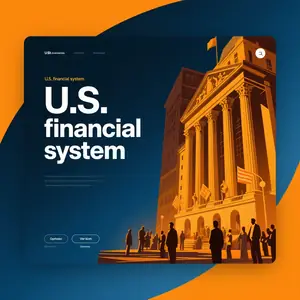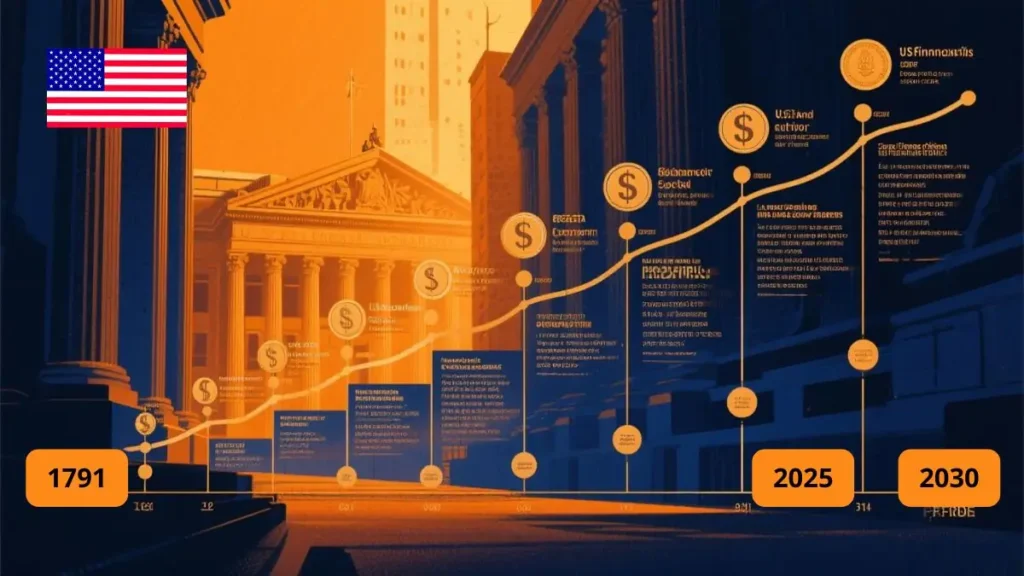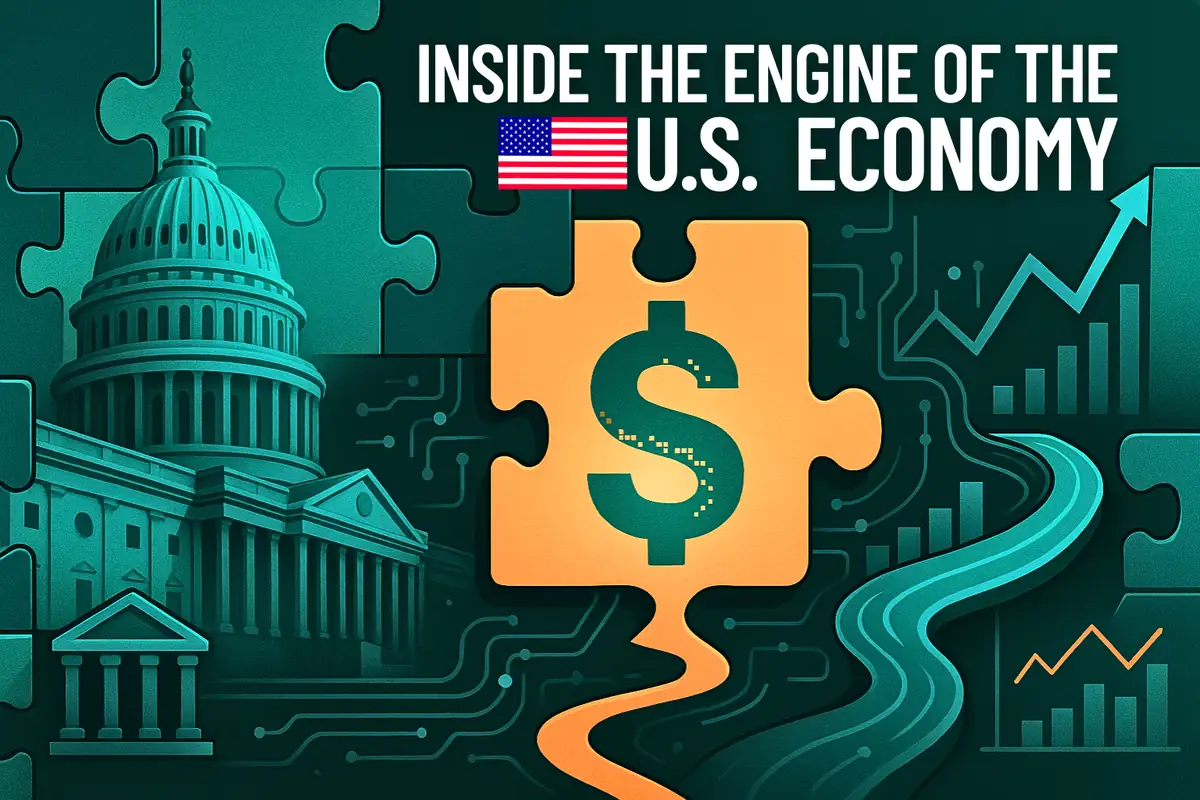The US financial system explained in simple terms has never been more crucial for everyday Americans. As the backbone of the world’s largest economy, understanding how money flows through institutions, markets, and regulatory bodies empowers consumers to make smarter financial decisions. Whether you’re opening your first bank account, applying for credit, or planning for retirement, navigating the complex web of the US financial system can seem overwhelming—but it doesn’t have to be.
This comprehensive guide breaks down the financial institutions USA residents interact with daily and provides essential knowledge about consumer finance USA regulations that protect your money. By the end, you’ll have a clear roadmap to confidently navigate America’s financial landscape and make informed decisions that benefit your financial health.

Summary | In this complete guide you will find:
The Foundation of the US Financial System Explained
The US financial system explained at its core reveals a complex network designed to facilitate the flow of money between savers, borrowers, investors, and institutions. This intricate system forms the foundation upon which the American economy operates, enabling everything from simple transactions to sophisticated investments.
Historical Development of America’s Financial Structure
The US financial system has evolved dramatically since the country’s founding. From the establishment of the First Bank of the United States in 1791 to the financial reforms following the 2008 crisis, understanding this history provides context for how the US financial system explained today came to be. The system’s development reflects America’s economic growth, policy priorities, and responses to financial crises throughout history.
Major milestones in the US financial system include the creation of the Federal Reserve in 1913, the Glass-Steagall Act of 1933 (later repealed in 1999), and the Dodd-Frank Wall Street Reform and Consumer Protection Act of 2010. Each of these transformative events reshaped how the US financial system explained to consumers functions in practice.
Three-Tier Banking Structure
When the US financial system explained to newcomers, the three-tier banking structure stands out as uniquely American. This system consists of:
| Banking Level | Description | Primary Regulator |
|---|---|---|
| National Banks | Large institutions operating nationwide | Office of the Comptroller of the Currency (OCC) |
| State Banks | Banks chartered by individual states | State banking departments and FDIC |
| Community Banks | Smaller, locally-focused institutions | FDIC and state regulators |
This three-tiered approach creates a diverse banking ecosystem that serves various needs within the US financial system explained through its institutional structure. The diversification provides consumers with multiple options while distributing risk throughout the system.
Did You Know? The US financial system explained in numbers is staggering: it comprises over 5,000 banks, 5,000+ credit unions, and manages more than $100 trillion in financial assets.

Key Players in America’s Financial Landscape
Understanding the US financial system explained in practical terms requires knowledge of its key participants. These institutions collectively create the infrastructure that enables money to move efficiently throughout the economy.
The Federal Reserve System
As America’s central bank, the Federal Reserve (often called “the Fed”) stands at the heart of the US financial system explained to consumers. Created in 1913, the Fed’s responsibilities include:
- Conducting monetary policy to promote employment and maintain price stability
- Ensuring the safety and soundness of the nation’s banking and financial system
- Providing financial services to depository institutions
- Promoting consumer protection and community development
The Federal Reserve’s 12 regional banks form a nationwide network that implements monetary policy decisions made by the Federal Open Market Committee (FOMC). When you hear about interest rates rising or falling, it’s typically the Fed’s actions influencing this critical aspect of the US financial system explained in news headlines.
Commercial Banks and Credit Unions
Commercial banks represent the most visible financial institutions USA residents interact with regularly. These for-profit entities accept deposits, make loans, and provide essential financial services. From giants like JPMorgan Chase and Bank of America to local community banks, these institutions serve as the primary interface between consumers and the US financial system explained in everyday transactions.
Credit unions offer similar services but operate as member-owned, not-for-profit cooperatives. This structural difference within the US financial system explained through organizational models often results in credit unions offering more favorable interest rates on savings accounts and loans to their members.
Investment Banks and Broker-Dealers
Investment banks like Goldman Sachs and Morgan Stanley serve different functions in the US financial system explained through their capital market activities. These institutions:
- Underwrite new securities issuances
- Facilitate mergers and acquisitions
- Provide market-making services
- Offer wealth management for high-net-worth individuals
Broker-dealers, meanwhile, execute securities transactions for clients and often conduct proprietary trading. They play a crucial role in maintaining liquidity within the US financial system explained through market operations.
Quick Tip: When seeking financial advice, understand whether your advisor works for a commercial bank, credit union, or investment bank, as this affects the products they can offer and their compensation structure.

The Banking System: Your Money’s First Stop
The banking sector forms the foundation of the US financial system explained for everyday consumers. This is where most Americans first interact with financial services, through checking accounts, savings accounts, and loans.
How Banks Function Within the U.S. Financial System
Banks operate on a fractional reserve system, a fundamental concept in the US financial system explained through its money creation process. When you deposit $1,000, the bank doesn’t simply hold that entire amount in a vault. Instead, regulations require them to keep only a fraction (the “reserve requirement”) on hand, while lending out the remainder to other customers.
This lending creates new money in the U.S. financial system explained through what economists call the “money multiplier effect.” Your $1,000 deposit might enable several thousand dollars in new loans throughout the economy, expanding the money supply and facilitating economic growth.
Deposit Insurance: FDIC and NCUA Protection
One of the most important consumer protections in the US financial system explained to savers is deposit insurance. The Federal Deposit Insurance Corporation (FDIC) insures deposits at banks, while the National Credit Union Administration (NCUA) provides similar protection for credit union members.
These insurance programs guarantee up to $250,000 per depositor, per insured bank, for each account ownership category. This critical safeguard of the U.S. financial system explained in practical terms means that even if your bank fails, your money remains protected up to the insurance limits.
“The fractional reserve banking system is the engine that powers economic growth in America, multiplying the impact of each dollar deposited through a carefully regulated lending process.”
— Dr. Sarah Johnson, Professor of Economics, University of Chicago

Financial Markets and Investment Mechanisms
Beyond basic banking, the US financial system explained in its complete form includes sophisticated markets where securities are traded, from stocks and bonds to derivatives and commodities. These markets facilitate capital formation and economic growth.
Stock Markets: Equities Trading
Stock exchanges like the New York Stock Exchange (NYSE) and NASDAQ represent highly visible components of the U.S. financial system explained through market infrastructure. These platforms enable companies to raise capital by selling ownership shares (equities) to the public.
For individual investors, understanding these markets is crucial to participating in the U.S. financial system explained through investment opportunities. Whether through direct stock purchases or retirement accounts like 401(k)s and IRAs, most Americans have some stake in these markets.
Bond Markets: Debt Securities
The bond market, though less visible to everyday consumers, is actually larger than the stock market in the US financial system explained by trading volume. Here, governments, municipalities, and corporations borrow money by issuing debt securities with promised interest payments.
US Treasury securities represent the largest and most liquid segment of this market, considered the safest investment in the US financial system explained through risk assessment. Treasury yields serve as benchmarks for other interest rates throughout the economy.
Important: When investing in financial markets, diversification across different asset classes helps manage risk within the US financial system explained through investment principles. Never invest money you cannot afford to lose.
Money Markets: Short-Term Liquidity
Money markets facilitate short-term borrowing and lending, typically for periods of one year or less. These markets are essential to the U.S. financial system explained through its liquidity management mechanisms. Instruments like Treasury bills, commercial paper, and certificates of deposit provide low-risk options for short-term cash management.
| Market Type | Primary Instruments | Typical Investors |
|---|---|---|
| Stock Markets | Common stocks, ETFs, preferred shares | Individual investors, pension funds, mutual funds |
| Bond Markets | Treasury securities, municipal bonds, corporate bonds | Institutional investors, retirement funds, wealthy individuals |
| Money Markets | T-bills, commercial paper, repos | Banks, corporations, money market funds |
Financial Regulators: Protecting Consumers and Markets
Regulation is a cornerstone of the U.S. financial system explained through its oversight mechanisms. Multiple agencies monitor different aspects of the financial landscape to ensure stability, fairness, and consumer protection.
The Regulatory Framework
Understanding the U.S. financial system explained through its regulatory structure requires familiarity with several key agencies:
- Federal Reserve: Oversees bank holding companies and state-chartered member banks
- Office of the Comptroller of the Currency (OCC): Regulates national banks
- Federal Deposit Insurance Corporation (FDIC): Insures deposits and supervises state-chartered banks that aren’t Federal Reserve members
- Securities and Exchange Commission (SEC): Regulates securities markets and protects investors
- Consumer Financial Protection Bureau (CFPB): Focuses specifically on consumer protection in financial products and services
This complex network of oversight creates multiple layers of protection within the U.S. financial system explained to consumers concerned about security and fairness.
Consumer Protection Laws
Several important laws protect consumers navigating the US financial system explained through its regulatory safeguards:
- Truth in Lending Act (TILA): Requires clear disclosure of loan terms and costs
- Fair Credit Reporting Act (FCRA): Governs the collection and use of consumer credit information
- Electronic Fund Transfer Act (EFTA): Establishes rights for consumers using electronic payments
- Credit CARD Act: Provides protections against unfair credit card practices
These regulations form a critical component of the U.S. financial system explained through consumer rights and protections. They ensure transparency and fairness in financial transactions.
Consumer Alert: If you believe your rights have been violated within the US financial system, explained complaints processes exist through the CFPB’s complaint portal at consumerfinance.gov/complaint.

Consumer Finance: Products and Services
Consumer finance USA products and services represent the most direct ways Americans interact with the financial system. From everyday banking to long-term investing, these tools help individuals manage their money and build wealth.
Banking Products: Accounts and Services
Core banking products in the US financial system explained for consumers include:
- Checking accounts: For everyday transactions and bill payments
- Savings accounts: For emergency funds and short-term goals
- Certificates of Deposit (CDs): Fixed-term deposits with higher interest rates
- Money Market Accounts: Combine features of checking and savings with higher yields
Digital innovations have transformed consumer finance USA banking experiences, with mobile apps and online platforms providing 24/7 access to the US financial system explained through modern technology. Features like mobile check deposit, peer-to-peer payments, and automatic savings tools have simplified financial management.
Credit Products and Lending
Credit represents a significant aspect of consumer finance USA practices. The US financial system explained through its lending mechanisms offers several credit products:
- Credit cards: Revolving credit lines for purchases
- Mortgages: Loans for home purchases
- Auto loans: Financing for vehicle purchases
- Personal loans: Unsecured loans for various purposes
- Student loans: Financing for higher education
Understanding how credit scores function is essential when navigating consumer finance USA lending processes. The US financial system explained through credit reporting relies primarily on FICO and VantageScore models, with scores ranging from 300 to 850. Higher scores unlock better interest rates and terms.
Investment and Retirement Accounts
Long-term wealth building in the US financial system explained for individual investors typically involves:
- 401(k) and 403(b) plans: Employer-sponsored retirement accounts
- Individual Retirement Accounts (IRAs): Personal retirement vehicles
- Brokerage accounts: For direct market investments
- 529 plans: Tax-advantaged education savings
- Health Savings Accounts (HSAs): Tax-advantaged medical expense funds
These vehicles provide access to broader markets within the US financial system explained through investment opportunities. They offer various tax advantages designed to encourage long-term saving.
“Financial literacy isn’t just about understanding products—it’s about understanding how those products fit into your unique financial journey and goals.”
— Maria Rodriguez, Certified Financial Planner and Consumer Advocate

Successfully navigating the US financial system explained in practical terms requires both knowledge and strategy. Here’s how consumers can effectively manage their financial lives within this complex landscape.
Building a Strong Financial Foundation
The journey through consumer finance USA practices typically begins with these foundational steps:
- Establishing emergency savings: Most financial experts recommend 3-6 months of essential expenses
- Managing debt strategically: Prioritizing high-interest debt while maintaining minimum payments on all obligations
- Building credit history: Establishing and maintaining good credit opens doors in the US financial system explained through lending criteria
- Creating a personal financial plan: Setting clear goals with specific timelines and strategies
These basic building blocks create stability that allows individuals to take advantage of more advanced opportunities within the US financial system explained through its wealth-building mechanisms.
Choosing Financial Institutions and Products
When selecting from financial institutions USA consumers have numerous options. Consider:
- Fee structures: Particularly monthly maintenance fees, overdraft fees, and ATM charges
- Interest rates: Compare yields on savings products and costs on lending products
- Digital capabilities: Evaluate the quality of online and mobile banking platforms
- Branch and ATM access: If physical locations matter to you
- Customer service quality: Research reputation and availability of support
Remember that no single institution may be ideal for all your needs in the U.S. financial system explained through product specialization. Many consumers maintain relationships with multiple providers: perhaps a local credit union for checking, an online bank for high-yield savings, and a national broker for investments.
Pro Strategy: Consider a “hub and spoke” approach to the US financial system explained through account management: use one primary checking account as your financial hub, connected to specialized accounts (the spokes) for specific purposes like high-yield savings or investments.
Protecting Yourself in the Financial System
Financial security is paramount when interacting with the US financial system explained through its risks and protections:
- Monitor accounts regularly for unauthorized transactions
- Use strong, unique passwords for financial accounts
- Enable two-factor authentication when available
- Check credit reports annually through AnnualCreditReport.com
- Consider credit freezes if you’re not actively applying for new credit
- Be wary of unsolicited financial offers and “too good to be true” opportunities
Understanding consumer rights within the US financial system explained earlier provides additional protection. Don’t hesitate to file complaints with appropriate regulatory agencies if institutions violate these rights.

Common Challenges and Solutions
Even with proper knowledge of the US financial system explained in detail, consumers often face challenges. Understanding these common obstacles and their solutions helps navigate the system more effectively.
Access and Inclusion Issues
Not all Americans have equal access to the US financial system explained previously. Approximately 5.4% of households remain unbanked, meaning they lack basic checking or savings accounts. This exclusion often affects lower-income communities, minorities, and rural populations.
Solutions to banking access challenges include:
- Bank On certified accounts: Low-cost accounts with no overdraft fees
- Community Development Financial Institutions (CDFIs): Mission-driven institutions serving underbanked communities
- Credit union membership: Often more accessible than traditional banks with community-focused missions
- Mobile banking solutions: Reducing the need for physical branch access
Managing Debt Effectively
Debt can become overwhelming within the US financial system explained through its credit mechanisms. Americans collectively hold over $15 trillion in household debt across mortgages, student loans, auto loans, and credit cards.
Effective debt management strategies include:
- Debt avalanche method: Focusing extra payments on highest-interest debt first
- Debt snowball method: Paying off smallest balances first for psychological wins
- Balance transfer opportunities: Using promotional rates to reduce interest costs
- Income-driven repayment plans: For federal student loans
- Debt consolidation: Combining multiple debts into a single, lower-interest loan
In extreme cases, credit counseling, debt management plans, or even bankruptcy may be appropriate options within the US financial system explained through its debt relief mechanisms.
Navigating Financial Complexity
The sheer complexity of the US financial system explained throughout this article creates challenges for consumers. Financial jargon, complicated fee structures, and numerous product options can lead to suboptimal decisions.
Strategies for managing complexity include:
- Focus on financial education through reputable resources
- Use comparison tools when shopping for financial products
- Consider working with fee-only financial advisors for complex decisions
- Break down large financial goals into smaller, manageable actions
- Automate good financial behaviors like saving and bill payment
“The most successful consumers in today’s financial system are those who combine knowledge with intentional action—understanding the system is just the first step toward financial empowerment.”
— Dr. Michael Chen, Consumer Finance Research Institute

The Future of the US Financial System
The US financial system explained thus far represents its current state, but significant changes are reshaping how consumers interact with money and institutions. Understanding these trends helps prepare for the evolving landscape.
Digital Transformation and Fintech
Financial technology (fintech) companies are challenging traditional models within the US financial system explained through disruption and innovation. Mobile payment platforms, robo-advisors, and digital-only banks offer alternatives to conventional financial institutions USA consumers have historically relied upon.
Blockchain technology and cryptocurrencies represent another frontier in the U.S. financial system explained through emerging technologies. While Bitcoin and other digital assets remain speculative investments, the underlying technology is influencing how financial institutions approach security, transparency, and transaction processing.
Regulatory Evolution
Regulation continues to evolve within the US financial system explained through policy development. Key trends include:
- Increasing focus on data privacy and security
- Expanded consumer protections in digital finance
- Potential regulatory frameworks for cryptocurrencies and digital assets
- Continued emphasis on financial inclusion initiatives
These regulatory developments will shape how the US financial system explained to future generations operates and protects consumers.
Emerging Financial Models
New approaches to financial services are gaining traction within the US financial system explained through business model innovation:
- Banking-as-a-Service (BaaS): Allowing non-banks to offer financial products
- Embedded finance: Integrating financial services into non-financial platforms
- Open banking: Enabling data sharing between financial institutions with consumer consent
- Decentralized finance (DeFi): Creating financial instruments without centralized intermediaries
These models have the potential to increase access, reduce costs, and create more personalized experiences in consumer finance USA practices.
Looking Ahead: As the US financial system explained in this article continues to evolve, maintaining financial literacy will become increasingly important. Stay informed through reputable sources and be willing to adapt your strategies as new tools and opportunities emerge.

What are the main components of the U.S. financial system explained simply?
The U.S. financial system consists of four main components: financial institutions (banks, credit unions, investment firms), financial markets (stock, bond, and money markets), financial instruments (stocks, bonds, derivatives), and financial regulators (Federal Reserve, SEC, FDIC). These components work together to facilitate the flow of money between savers and borrowers, enable investments, and support economic growth. The system is designed with checks and balances to promote stability while providing consumers with various financial services and products to meet their needs.
How does the Federal Reserve influence the US financial system?
The Federal Reserve (“the Fed”) influences the US financial system through several powerful mechanisms. It sets monetary policy by adjusting interest rates, which impacts borrowing costs throughout the economy. The Fed regulates and supervises financial institutions to ensure safety and stability. It provides financial services to depository institutions and the U.S. government. It also manages the nation’s money supply through open market operations, reserve requirements, and the discount rate. These actions collectively impact everything from mortgage rates to inflation levels, making the Fed the most influential entity in the U.S. financial system explained through its monetary policy implementation.
What’s the difference between banks and credit unions in the financial institutions USA landscape?
In the landscape of financial institutions USA consumers can access, banks and credit unions differ primarily in their structure and purpose. Banks are for-profit corporations owned by shareholders and focused on maximizing profits. Credit unions are non-profit cooperatives owned by their members (customers) and focused on serving those members. This fundamental difference often leads to credit unions offering higher interest rates on savings, lower rates on loans, and fewer fees compared to banks. Banks typically have more branches, ATMs, and sophisticated digital tools, while credit unions often provide more personalized service. Banks are insured by the FDIC, while credit unions are insured by the NCUA, both protecting deposits up to $250,000.
How is my money protected in the U.S. financial system?
Your money in the U.S. financial system is protected through multiple safeguards. Bank and credit union deposits are insured up to $250,000 per depositor, per institution, by the FDIC and NCUA respectively. Securities investments (stocks, bonds) held by brokerages are protected against broker failure (not market losses) by the Securities Investor Protection Corporation (SIPC) up to $500,000. Regulatory oversight from agencies like the Federal Reserve, SEC, and CFPB enforce rules that prevent fraud and ensure fair treatment. Consumer protection laws like the Truth in Lending Act and Fair Credit Reporting Act establish clear rights. Additionally, financial institutions implement sophisticated security measures to protect digital transactions and personal information.
What are the benefits of understanding consumer finance USA regulations?
Understanding consumer finance USA regulations empowers you to make better financial decisions in several ways. First, it helps you recognize and exercise your legal rights regarding financial products and services. Second, it enables you to identify potentially predatory practices or unfair terms. Third, it helps you leverage consumer protections like dispute resolution processes, error correction procedures, and fraud liability limits. Fourth, knowledge of regulations helps you compare financial products more effectively, understanding the true costs and benefits. Finally, regulatory understanding supports financial planning, as you can better navigate tax advantages, retirement account rules, and investment restrictions that might impact your long-term financial goals.
What common challenges do consumers face in the US financial system explained?
Consumers in the US financial system face several common challenges. Financial literacy gaps make it difficult to understand complex products and services. High fees and interest rates can erode wealth, particularly for those with limited options. Limited access to banking services affects approximately 5.4% of households who remain unbanked. Credit building and maintenance challenges impact borrowing ability and costs. Information asymmetry between financial institutions and consumers can lead to disadvantageous decisions. Digital security concerns including identity theft and fraud present ongoing risks. Navigating retirement planning complexity across various account types and investment options poses difficulties for many Americans. Finally, predatory lending practices continue to target vulnerable populations despite regulatory protections.
How is the US financial system changing with technology?
The US financial system explained in terms of technological change is undergoing rapid transformation. Digital banking is replacing physical branches, with mobile apps handling most transactions. Fintech companies are disrupting traditional financial institutions USA have relied on for centuries, offering specialized services with lower costs and greater convenience. Artificial intelligence and machine learning are revolutionizing credit decisions, fraud detection, and investment management. Blockchain technology and cryptocurrencies are creating alternative financial channels outside traditional banking networks. Open banking initiatives are enabling greater data sharing between institutions with consumer consent. Automated financial management tools help consumers budget, save, and invest more effectively. Biometric authentication is enhancing security while simplifying access. These technological advances are making financial services more accessible, personalized, and efficient.
Conclusion: Empowerment Through Understanding the U.S. Financial System
The U.S. financial system explained throughout this comprehensive guide represents a complex but navigable landscape that impacts every American’s daily life. From the checking account where you deposit your paycheck to the retirement investments that will fund your future, understanding how money flows through institutions, markets, and regulatory frameworks empowers better financial decisions.
Trusted References
- Federal Reserve Education – Official educational resources from the U.S. Central Bank explaining how the American financial system works, with interactive tools and detailed information. Learn more at: https://www.federalreserveeducation.org/about-the-fed/structure-and-functions
- Consumer Financial Protection Bureau – Essential information about financial consumer protection and the rights of American citizens within the financial system, including guides and tools for better financial decisions. Learn more at: https://www.consumerfinance.gov/consumer-tools/money-as-you-grow/

Author: Michael holds an MBA in business management. He worked for 5 years as an investment consultant. He also works as a freelancer for a security company. He is the creator and writer of the finance article WalletWise.blog — where he shares practical tips and his experiences. His mission is to make the financial world simpler, more accessible and free of hidden fees.
Simple strategies, great results. Make your money count!


![15 Powerful Income Boosting Strategies That Work in 2025 [Expert Guide] 12 Increase Income: Career Growth Tips and Income Boosting Ideas in 2025](https://walletwise.blog/wp-content/uploads/2025/05/Increase-Income-2025-man-305x207.webp)

